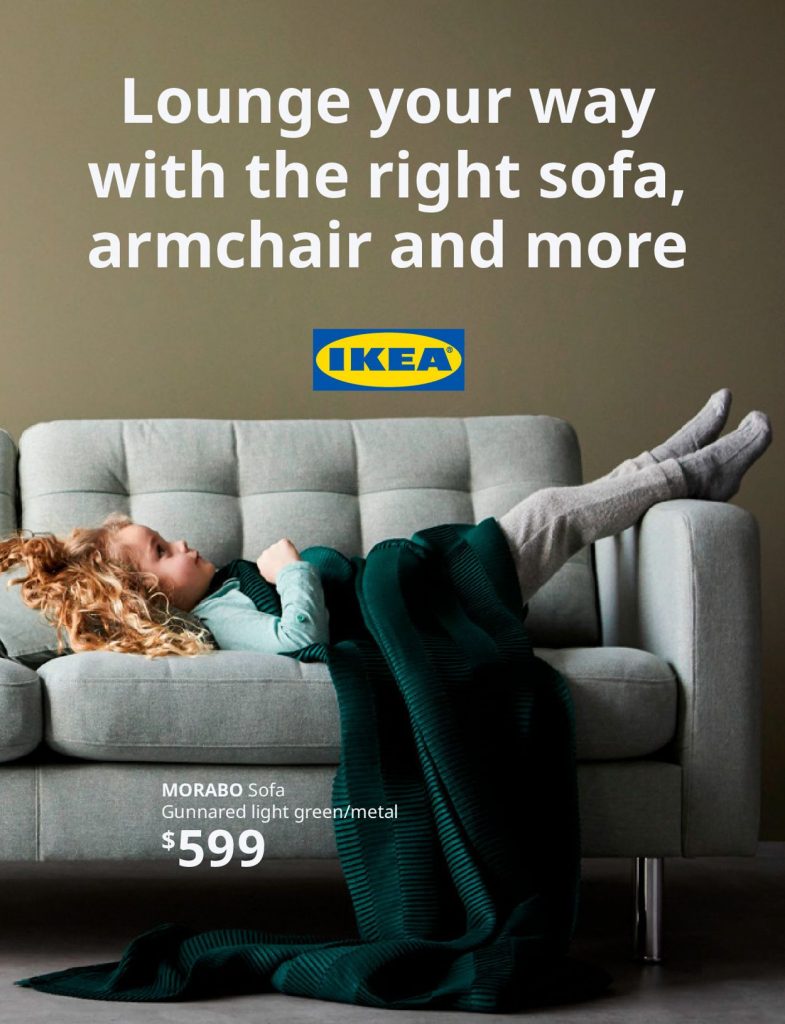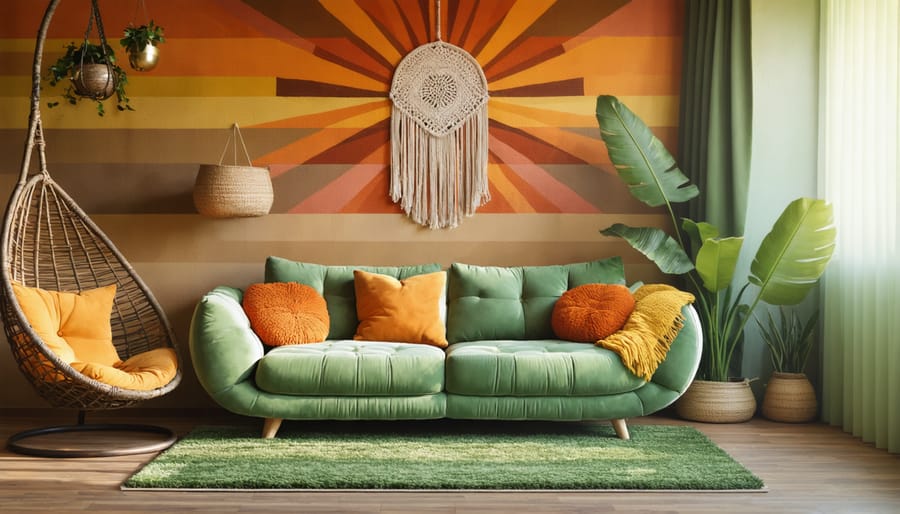
How 70s Decor is Making Your Home Feel Groovy Again
Transform your living space with the bold patterns and earthy warmth of the 70s home decor comeback. Orange and brown sunburst wallpaper, geometric-patterned shag carpets, and curved furniture pieces instantly capture the decade’s signature swagger. Layer mushroom lamps and macramé wall hangings against wood-paneled accent walls for authentic vintage depth. Mix brass fixtures, rattan peacock chairs, and chunky ceramic pieces to create conversation areas that feel both nostalgic and fresh. Today’s interpretation of 70s style seamlessly blends retro statement pieces with modern functionality, letting you channel that groovy vibe without sacrificing contemporary comfort. Whether you’re diving into a full renovation or simply adding accent pieces, the 70s aesthetic offers endless possibilities for creating spaces that are both bold and inviting. The era’s fearless approach to color, texture, and form continues to influence modern design, proving that some styles truly are timeless.
Key Elements of 70s Home Decor
Color Palettes That Defined an Era
The 1970s were defined by a distinctive color palette that perfectly captured the era’s bold and expressive spirit. Harvest gold, a warm, metallic yellow, dominated kitchens and living spaces, often appearing on appliances and wall coverings. Its popular companion, avocado green, brought the organic movement indoors, showing up on everything from shag carpets to bathroom fixtures.
Burnt orange emerged as a signature shade, adding warmth and energy to rooms through accent pieces and statement walls. Earth tones ruled supreme, with rich browns, deep terracotta, and warm beiges creating a natural, grounded feeling throughout homes. These colors weren’t just randomly chosen – they reflected the decade’s growing environmental awareness and connection to nature.
To authentically capture this era in modern spaces, consider combining two or three of these classic shades. For a subtle nod to the 70s, try incorporating harvest gold throw pillows against a neutral sofa, or paint a single accent wall in rich burnt orange. The key is balance – while these colors are bold, they can work beautifully in contemporary settings when thoughtfully applied.
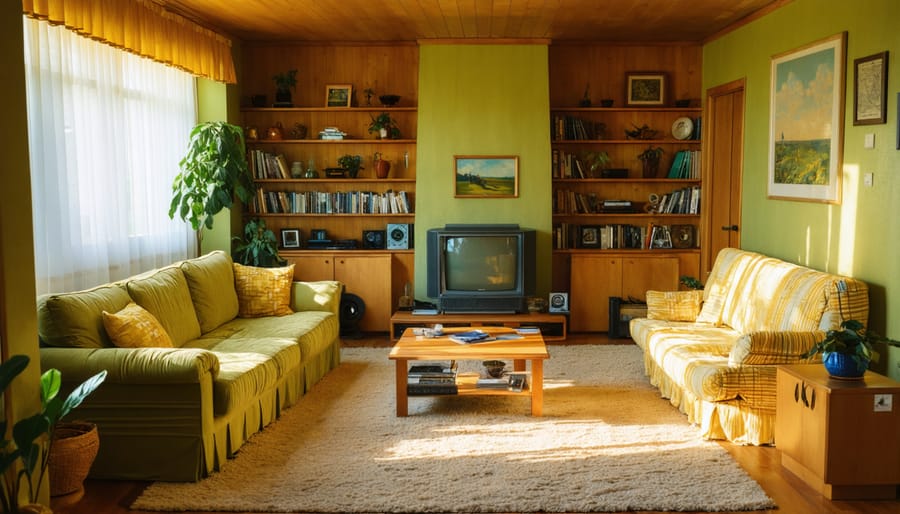
Signature Materials and Textures
The 1970s introduced a rich tapestry of distinctive materials and textures that defined the era’s interior design. Shag carpeting, with its deep, luxurious pile, was the crown jewel of ’70s flooring, appearing in bold colors like harvest gold, avocado green, and burnt orange. These plush carpets didn’t just cover floors – they often extended up walls, creating an immersive, cozy atmosphere.
Wood paneling emerged as another quintessential element, with dark-stained variations dominating living rooms and basements. The warm, natural tones of oak and pine panels created a rustic yet sophisticated ambiance that perfectly complemented the era’s organic design philosophy.
Macramé took the ’70s by storm, introducing intricate knotted designs in wall hangings, plant holders, and decorative room dividers. These handcrafted pieces added texture and bohemian flair while showcasing natural fibers like jute and cotton. Cork was another prevalent material, appearing on walls, bulletin boards, and even as flooring, bringing warmth and acoustic benefits to spaces.
Velvet and corduroy upholstery dominated furniture pieces, offering both visual and tactile appeal. These materials appeared on everything from sectional sofas to oversized armchairs, often in earth tones or vibrant jewel colors. Vinyl and plastic, celebrated for their durability and modern appeal, rounded out the era’s material palette, appearing in furniture, accessories, and innovative modular storage solutions.
Iconic 70s Furniture Pieces
Statement Seating
The 1970s revolutionized how we think about living room seating, introducing bold designs that encouraged social interaction. Perhaps nothing epitomizes this era more than the iconic sunken living room and conversation pit. These architectural features, set a few steps below the main floor level, created intimate gathering spaces that practically demanded social interaction.
Conversation pits often featured built-in seating wrapped around a central coffee table, typically dressed in vibrant fabrics like orange, brown, or mustard yellow. These cozy nooks were perfect for cocktail parties and casual gatherings, reflecting the decade’s emphasis on informal entertaining.
Statement chairs were equally important in defining 70s seating. The Eames Lounge Chair, though introduced in the 50s, reached peak popularity during this era. Meanwhile, the Pod Chair and Egg Chair became synonymous with space-age style, offering cocoon-like comfort with a futuristic twist. Papasan chairs, with their round wicker frames and plush cushions, brought a bohemian touch to any room.
For a modern take on these classics, consider creating a conversation area with modular seating in contemporary fabrics while maintaining those characteristic 70s shapes. While actual sunken living rooms might be challenging to implement today, you can achieve a similar effect by arranging seating in a circular pattern and using area rugs to define the space. Look for vintage-inspired pieces that capture the era’s organic forms and bold presence without overwhelming your existing décor.
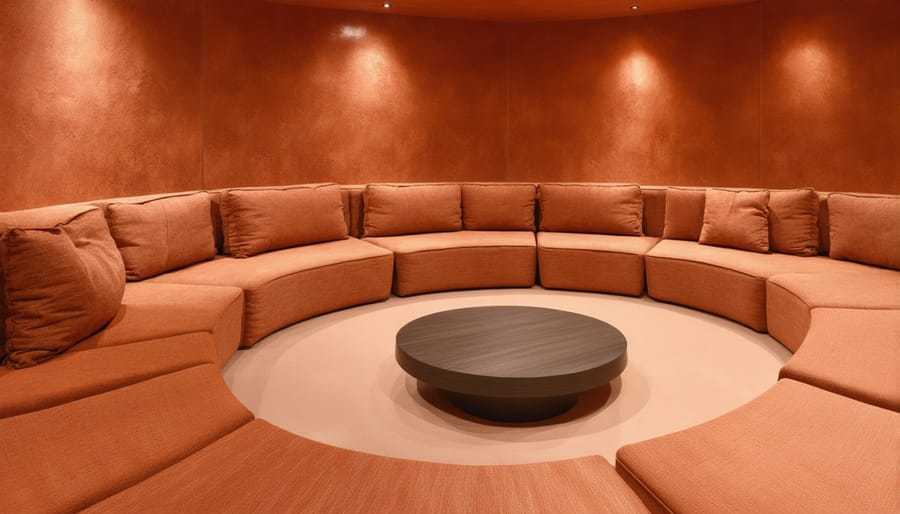
Storage and Display
Storage solutions in the 1970s were all about making bold statements while maximizing space. The iconic wall unit was the cornerstone of 70s storage, featuring modular components in rich wood tones like teak and walnut. These versatile pieces often combined open shelving, closed cabinets, and space for the era’s must-have entertainment systems.
Room dividers were another quintessential element, serving both practical and aesthetic purposes. Popular styles included geometric patterns in wood and metal, sometimes incorporating frosted glass or macramé elements. These pieces helped define separate living spaces while maintaining an open-plan feel that was signature to the decade.
Floating shelves and wall-mounted storage systems were revolutionary for their time. Often featuring adjustable components, these systems allowed homeowners to customize their storage solutions. The most popular materials included chrome, wood veneer, and plastic in earth tones like harvest gold and burnt orange.
Display areas were carefully curated spaces for showing off collections of ceramics, plants, and other decorative items. Glass-fronted cabinets and illuminated display sections were common features, often incorporating mirrors to enhance the sense of space and light. Many units included dedicated spaces for record players and vinyl collections, reflecting the era’s strong music culture.
Today, you can recreate this look by mixing vintage pieces with modern storage solutions in similar materials and colors. Look for modular systems that echo the clean lines and warm materials of the original 70s designs.
Modern Ways to Rock 70s Style
Subtle 70s Touches
Not everyone wants to transform their entire home into a 70s time capsule, and that’s perfectly fine! Incorporating vintage elements in modern spaces can be done with a light touch that adds character without overwhelming your existing décor.
Start with textiles – throw a geometric-patterned cushion or two on your sofa, or hang a macramé wall hanging in a corner. Small ceramic pieces in earth tones, like vases or planters, can add authentic 70s charm without dominating the room. Consider swapping out a plain pendant light for a woven rattan shade, or add a sunburst mirror as a focal point.
Plants were huge in the 70s, and they’re trending again now. A few hanging spider plants or a statement monstera can instantly evoke that retro vibe. For a pop of color, try adding orange, avocado green, or harvest gold accents through small decorative items like candleholders or picture frames.
Don’t forget the power of artwork – a single framed vintage poster or abstract print can set the tone without requiring a complete room makeover. Even something as simple as switching out drawer pulls for brass or wood versions can add that subtle 70s touch you’re looking for.
Bold Statement Pieces
When it comes to making a bold statement with 70s decor, it’s all about choosing those show-stopping pieces that capture the era’s fearless spirit. Among the many timeless vintage design ideas, oversized arc floor lamps and conversation pits stand out as quintessential 70s elements that can transform any space.
Consider incorporating a dramatic sunburst mirror as your room’s centerpiece – these iconic pieces instantly draw the eye and reflect light beautifully throughout your space. Massive macramé wall hangings, spanning from ceiling to floor, create texture and visual interest while perfectly embodying the decade’s artistic flair.
For seating, opt for statement pieces like the iconic Egg Chair or a bold-colored modular sofa in burnt orange or harvest gold. These pieces aren’t just furniture; they’re conversation starters that anchor your room’s design. Large ceramic floor vases in earth tones, standing proudly in corners or flanking entertainment units, add height and drama to your space.
Don’t shy away from geometric wallpaper on an accent wall – think bold patterns in browns, oranges, or greens. Abstract art pieces featuring psychedelic designs or nature-inspired motifs can serve as stunning focal points. Remember, the key to successfully incorporating these bold elements is balancing them with neutral spaces to prevent visual overwhelm while maintaining that authentic 70s vibe.
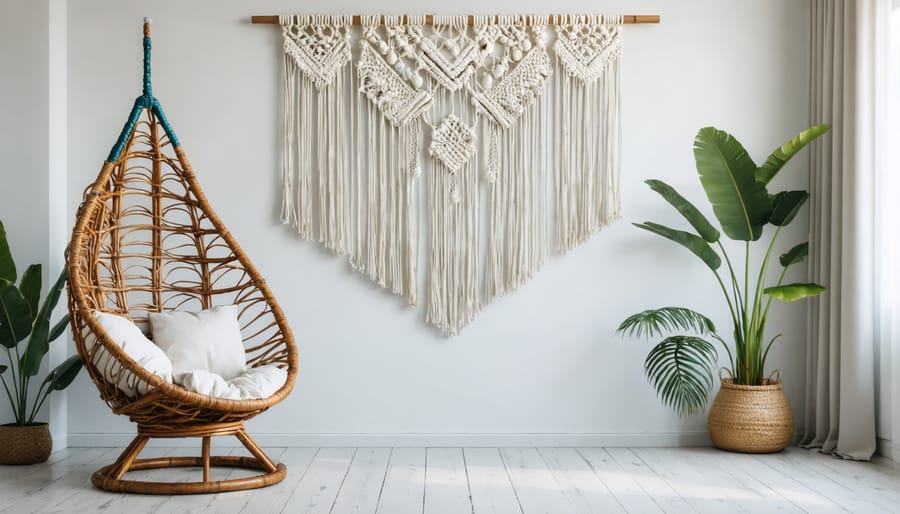
DIY 70s-Inspired Projects
Creating authentic 70s decor doesn’t have to break the bank. With a few simple DIY projects, you can capture that groovy vibe while adding personal touches to your space. Here’s how to craft some iconic 70s elements:
Macramé Wall Hanging
Gather cotton cord, a wooden dowel, and scissors. Start with basic square knots to create a simple pattern. As you gain confidence, experiment with more complex designs incorporating beads or dyed cord sections.
String Art
Using a wooden board, small nails, and colorful string or yarn, create geometric patterns typical of the era. Start by mapping your design with pencil, then hammer nails along the lines about 1-inch apart. Wrap string between nails to transform your space with art.
Pressed Flower Frame
Collect and press flowers between book pages for two weeks. Arrange dried flowers between two glass panels and secure with copper tape for a classic 70s look.
Tie-Dye Throw Pillows
Use natural cotton covers and fabric dye to create spiral or bull’s-eye patterns. Secure with rubber bands before dying for authentic results.
Wooden Bead Curtain
String wooden beads onto sturdy cord in varying lengths. Attach to a wooden rod for a room divider or doorway accent that captures that laid-back 70s atmosphere.
Remember to embrace imperfections – they add character and authenticity to your handmade pieces.
Shopping Guide for 70s Style
Finding authentic 70s pieces or quality reproductions doesn’t have to be a treasure hunt. Start your search at local vintage and antique stores, where you can often find original furniture, lighting fixtures, and decorative items. Estate sales and flea markets are goldmines for genuine 70s pieces, especially on weekends when new items are typically put out for display.
For online shopping, platforms like Etsy and eBay offer extensive collections of both vintage and reproduction items. Search for specific terms like “mid-century modern,” “space age,” or “bohemian 70s” to narrow down your results. Many sellers specialize in authentic 70s pieces and can provide detailed information about the item’s history and condition.
When hunting for larger furniture pieces, consider checking out specialty vintage furniture stores and online marketplaces like Chairish or 1stDibs. These platforms often have curated collections of authenticated vintage pieces, though they tend to be pricier than local finds.
For those on a budget, reproductions can be an excellent alternative. Retailers like West Elm, CB2, and Anthropologie frequently release collections inspired by 70s design. Look for characteristic features like curved lines, bold patterns, and warm earth tones to ensure authenticity in style.
Don’t forget to explore thrift stores and secondhand shops regularly – inventory changes frequently, and you never know when you might stumble upon a perfect piece. For textiles and smaller decor items, check out local craft fairs and makers’ markets, where artisans often create pieces inspired by retro designs.
Remember to thoroughly inspect any vintage pieces for damage and always verify measurements before purchasing, especially when buying online.
The 70s design aesthetic continues to captivate homeowners and interior designers alike, proving that great style truly is timeless. With its bold patterns, earthy color palettes, and emphasis on comfort and functionality, 70s decor offers a unique blend of nostalgia and modern appeal that resonates with today’s home styling preferences.
The key to successfully incorporating 70s elements lies in striking the right balance. Whether you’ve opted for statement pieces like a sunburst mirror or macramé wall hanging, or gone all-in with geometric wallpaper and shag carpeting, the goal is to create spaces that feel both authentic and livable in today’s context.
Remember that 70s decor isn’t just about aesthetics – it’s about creating welcoming, comfortable spaces that encourage social interaction and personal expression. The era’s focus on natural materials, handcrafted elements, and sustainable choices aligns perfectly with current design trends and environmental consciousness.
As you embark on your retro decorating journey, don’t feel pressured to recreate a museum-perfect 70s room. Instead, cherry-pick the elements that speak to you and blend them with contemporary pieces. Whether it’s through incorporating warm wood tones, adding funky vintage lighting, or experimenting with bold textiles, the 70s style offers endless possibilities for personalization while maintaining its characteristic charm and warmth.
The enduring appeal of 70s decor proves that good design never goes out of style – it simply evolves to meet the needs and tastes of each new generation.
